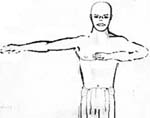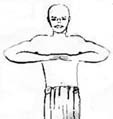-
Nā Keʻehi I Ka Haʻa - Hula Steps Contributed and Researched by Kalani N. Poʻomaiahealani -
- The following list is meant to encourage those
interested in the cultural dance of Hawaiʻi. You're
invited to learn what has been forgotten with the passage
of time. The first 26 dance steps (nā keʻehi i ka
haʻa) are recorded in the Hawaiian Dictionary authored by
Mary Kawena Pukui and Samuel H. Elbert. Most of
them are used today but others are probably unheard of by
many modern day students and still others have been
taught with different names. Some of the steps are called
by more than one name and will be listed together. There
are steps, nā keʻehi, that are not listed in the
dictionary as hula steps, but have names that describe
the action of the step and still there are others, with
names whose origin is obscure. Each of the 3 groups will
be listed separately. The term haʻa is used instead of
hula. Haʻa as defined in the dictionary : a dance with
bent knees; dancing; called hula after mid 1800's. To
simplify matters, the following explanations will be
given, beginning with a rightward movement.
1. ʻAi: dancing style or type
2. ʻAi ʻami: type of haʻa with little foot movement, hips revolve throughout the dance
3. ʻAi haʻa: hula step executed with bended knee
4. ʻAi kāwele, Kāwele: haʻa step;
one foot makes a half circle forward and to the side
without touching the floor; usually in combination with other steps as
the holo or ʻuwehe; used in "A Koʻolau Au"
5. ʻAmi: rotation of hips
6. ʻAmiʻami, ʻAmi
hula: jerking motion of the hips back and
forth in a crude or vulgar manner
7. ʻʻAmi kāhela, ʻAmi
poepoe: hip rotates with the weight on the
right hip as the left heel lifts very slightly, then reversing this action
8. ʻAmi kūkū: like the ʻami kāhela except the revolutions are smaller, faster and in groups of three; sometimes combined with two slower kāhele revolutions
9. ʻAmi kuʻupau (uninhibited), ʻAmi honua,
ʻAmi hue: rapid revolution of the hips in the haʻa;
an uninhibited ʻami, like in a Tahitian dance
10. ʻAmi ʻôniu (spinning): figure-eight
haʻa step; the revolving hips (ʻami) form an "8" with the
weight shifting
- 11. ʻAmi ʻōpū (stomach): ʻami haʻa step with
the abdomen thrust forward, considered in poor taste
- 12. ʻAui: haʻa
step where the dancer turns to the side and points the
foot out once or several times, drawing the foot well back between each pointing; at the same
time the body is tipped with the lowered hand pointing to the outpointing toes and the other hand raised in
the opposite direction.
In the hula "Kaulilua", this
step is immediately executed upon
the kahea "pa"
- 13. Hela: one foot is placed at about a 45 degree angle to the front/side with the weight on the opposite hip and the knees bent; the foot is then returned to the original position and the step is repeated with the other foot.
- 14. Holo: running holo step to the side,
similar to kaholo except the feet are not necessarily
brought together. Used in "Aua Ia I
Kamapuaʻa"
- 15. Hue: revolving of the hips in time with the drummer, who beats as fast as possible, to see which dancer can dance the longest. Similar to ʻai ʻami and done at the end of the program
- 16. Kaʻapuni: haʻa step now called around
the island; the dancer pivots on the ball of one foot in a complete
circle; the other foot takes four or
more steps to complete the circuit
- 17. Kāhele: Regular ʻami rotations. See ʻAmi kuku, Keʻehi #8
- 18. Kāholo: the haʻa vamp step, more common in modern than in ancient dances, consisting of 4 counts:
- #1 one foot is extended in a straight line to the
side
- #2 the other foot is brought along side
- #3 first foot is again extended in a straight line to the side
- #4 the other foot is again brought along side the first foot
- #2 the other foot is brought along side
19. Kāwelu, Kalākaua: One foot taps time with the heel, the toes being stationary while the other foot, flat position, steps forward and back, the same distance, 2 or more times. The step is repeated, reversing the feet. This step is called Kalakaua in English because it was used to begin the haʻa hula dedicated to King David Kalākaua. Some halaus use the term kalākaua when this step is done in place to differentiate from kāwelu as the same step (front and back) that moves progressively to either side
- 20. Kelamoku: hula
step invented by Hawaiian sailors. One foot swings alternately on
ball and heel of
same
foot while the other points the toes front and
back four times, then reversed; knees are bent, arms out,
bent at the elbows, with the hands held up and
fingers often snapping while swaying the body
21. Kîʻi, Wāewae Kîʻi: right foot points to the side (3:00), front (1:00), back into position with the left foot. Left foot repeats the same movements, side (9:00), front (11:00), back into position, on the opposite side. Some halaus incorporate an ʻuwehe when the 2 feet are back in the same position. This step is often used at the end of Olapa/Alaʻapapa dances. Legend says Hiʻiaka-i-ka-poli-o-Pele and Hopoe danced the hula on Puʻu Kiʻi, an islet at Ka-pueo-kahi harbor of Hana, Maui. It is said that this step was first danced here.
- 22. Lele: the
dancer walks forward lifting the heel with each step, with a slight
inward movement
- 23. Lele
ʻUwehe: the ʻuwehe and lele steps are
combined. Step with right foot, bringing the left foot
to a hela position, bring left
foot back into position beside right foot, then ʻuwehe.
Repeat on other side
- 24. ʻO: The
hip is thrust outward in a circular "O" movement; similar
to the kawelu except the foot pivots while
turning to the opposite direction
- 25. Ue, Uwe: haʻa step where the kahea: "e" imperative and "ue" is announced to the drummer and the beat is changed. The dancer extends the right foot forward with toes pointed, while both arms are brought forward to chest level with hands crossed and fingers tipped upward; the left hand stays up, while the right arm and foot swing back in an outward arc, ending with right foot pointing back. The right arm and foot are moved forward and the step is repeated to the left. Then three short steps are taken forward turning the body to the right. In the last movement, the left hand is forward and the right foot and arm are back. This step is often used to end pahu hula, i.e."Kaulilua"
26. ʻUlili: similar to ʻuwehe except only one heel at a time is raised.
- 27. ʻUwehe, ʻuehe, ʻuweke: one
foot is lifted with weight shifting to the opposite hip as that foot
is "Uehe" lowered; both knees are then pushed forward by
the quick raising of the heels, with continued swaying
of the hips from side to side. The actions are then repeated in reverse.
Step Names Not Found In the
Dictionary
The names of the following steps were probably
derived from their actions. Each step is described and
defined
27. 'Ai holoholo: same as #14 holo
28. Akalewa: sway the hips from one side to
the other
Definition: to sway the hips daintily and
gracefully
29. Haʻanapu: sway the hips from side to side
Definition: to sway as in a dance
30. Hehi: on the count
Definition: to stamp, tread, trample, step on,
trampling
#1 stamp the right foot while raising the left knee
to slightly below the hip
#2 stamp the heel of the same foot leaving the left
knee raised
#3 stamp the left foot while raising the right knee
to slightly below the hip
#4 stamp the heel of the same foot leaving the right
knee raised
31. Kuʻi: hop onto the right foot moving to
the right while bringing the left heel with the toes
pointing to the
extreme left, approximately 6" in front of the right
knee being sure that the body doesn't bounce
(isolate action to the legs). The hop is executed 4
times then repeated to the left. Note: a loud stomping
sound is preferred when executing the hops
Definition: 1. To pound, punch, strike; to
beat out; to churn, 2.To join, stitch, sew, splice, united; joined; seam
Hula kuʻi, any interpretive hula so called since the
days of Kalakaua; literally, joined
32. Kuʻi Molokaʻi: similar to the kʻui except
while hopping to the right as in the kuʻi, the left leg
is thrust outward to the left, fully extended. After the 4th
count to the right, repeat the movements to the left. Emphasize the stomping sound
Definition Molokaʻi: this dance (see hula kuʻi
Molokaʻi) originated on the island of Molokaʻi
33. Hilo Kuʻi: start by lightly touching the
ground with the right foot in an alternating heel-toe
movement. Starting with the heel and ending with the heel in 7
counts, with the foot returning to the starting posiion on the 8th count. When placing the heel, the toes
need to be pointing to the right at a 45' angle. When placing the toes, the foot should be perpendicular to
the ground with the heels now taking the extreme right position. All the while, the opposite foot
bearing the entire body weight shuffles across the floor to the right, alternating heel and toes, also in an 8
count. However, on the 1st count, the left foot remains stationary and begins the shuffle on the 2nd count
with the heel moving to the right first. The shuffle is accomplished by placing all the weight of the body
onto the ball of the left foot as the heel is moved to
the right, then transferring the weight to the heel as
the ball of the left foot is then moved the right. This movement is repeated until the right foot is returned
to the starting positon on the 8th count. The entire process is now repeated in the opposite direction
Definition Hilo: to twist, braid, spin;
twisted, braided
34. Kaholo Huli Hapahā: Quarter turn or holo/vamp step in a semi-circle. The name was coined by Kalani Poʻomaiahelani
35. Kiʻi Kuhi: To make time; keeping haʻa
gestures with left hand gestures front and back; right
hand taps
ʻuliʻuli on lap
36. Hoʻoholo, Glide, Slide: kaholo hula step in excess of 2 counts; usually 3 or 4 counts
37. Kao: this
step name is widely used but there is no origin for its usage or
meaning for the word
Usage: sway side to side
#1 strike the ball of the right foot firmly on the floor
#2 strike the heel of the same foot
#3 strike the ball of the left foot firmly on the floor
#4 strike the heel of the same foot
Usage: may have come from the chant "Uleipahu I Ka Motu"
-
Position #1 Kaholo-Vamp -
-


Position #2 Kāwelu, Kalākaua
-

Position #3 ʻAmi
-

Positon #4 ʻUwehe, ʻUweke -
-